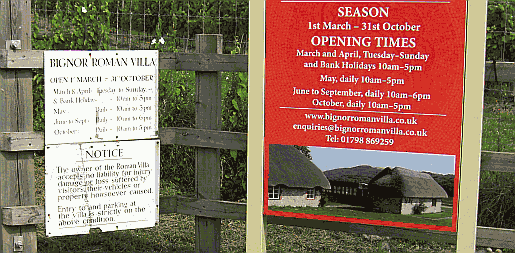
A short history of the Romans in West Sussex
Although being invaded is no-oneís cup of tea, in the long run the invasion of Sussex by the Romans in AD 43 and the 367 year Roman occupation of West Sussex was hugely beneficial to the county.
The Roman invasion of Sussex
Sussex was invaded by the Romans in AD 43 under the command of Titus Flavius Vespasianus, who later became the Emperor Vespasian. Itís not entirely clear where the Romans landed, although it is possible that Chichester Harbour was used.The Roman invasion in Sussex is sometimes portrayed as a friendly or invited one, but this glosses over the fighting that took place. Itís true that there wasnít as much bloodshed as in some other parts of Britain, like East Anglia, though.
Roman politics
Once the fighting was over the Romans decided the best way of achieving their objectives was to sponsor a local puppet king who already had authority over the people. Think of this as a tactic rather like the Americans are applying at the moment in Iraq and youíll realise that this probably wasnít always plain sailing.Tognidubnus (whose name is sometimes spelt Cogidubnus), one of the leading lights of the Regnenses tribe who lived in Sussex and Surrey was the man for the job. The Romans decided to build a strong garrison to protect their position and they chose Chichester as the site for it.
Roman Chichester
Although it is likely that the Regnenses already had some sort of settlement at Chichester, the Romans first beefed up the defences of the town and later set about expanding Chichesterís facilities. They called their town Noviomagus Reginorum.Unlike many architectural sites, itís very hard to be sure about the layout of Roman Chichester because the Norman, Medieval, Georgian and modern cities have successively been built on top of the Roman town. The best Roman buildings to have been identified so far were sited around the area immediately north of Chichesterís Market Cross.
There were Roman baths near West Street, buildings which were probably barracks in Chapel Street and in all likelihood a basilica under the site of Chichester Cathedral. There was also an amphitheatre which was excavated and then built over. This is located partly underneath and partly near the Market car park towards Whyke.
One part of Roman Chichester than can easily be seen is The Cogidubnus Stone recording the erection of a temple to Minerva by the Guild of Smiths. This was excavated in 1723 and is now sited on the outside of the Assembly Rooms in North Street, Chichester.
Roman Villas and Palaces in Sussex
Sussex has two great Roman sites.Fishbourne Roman Palace is probably the best preserved, best presented and largest Roman Palace in Britain. Even though a large part of the original Palace and its estate is buried under the village of Fishbourne and may be lost forever, itís clear that this was a substantial seat of power and the wealth. It is likely that Togidubnus and his successors lived here.
In Roman times the Birdham Channel of Chichester Harbour would have been navigable right up to Fishbourne Creek and so the Palace was well sited to control all the important international traffic within this small corner of the Roman Empire.
Bignor Roman Villa is another fine Roman building, discovered like so many great archaeological sites by accident. It is now a fine museum, although on a smaller scale than Fishbourne. Bignor is really a farmstead.
But there are plenty of other traces of the Romans in Sussex besides these two great Roman buildings.
There are the remains of Roman villas at Angmering, Arundel, Southwick, West Blatchington, Chilgrove and UpMarden. Many other traces of Roman buildings, plus other artefacts have been excavated or noted too.
Stane Street
The biggest physical mark the Romans left on Sussex is Stane Street Ė the great, straight road from Chichester to London.Stane Street is, like the stereotypical Roman Road, unerringly straight. If you stand on the Downs above Gumber Farm north of Slindon and look along Stane Street it points exactly towards the spire of Chichester Cathedral 10 miles away.
Stane Street was part of a highly efficient military machine. There are the remains of posting stations at Hardham near Pulborough and Alfoldean near Horsham which helped to relay messages along this Roman motorway.
Another posting station has been discovered at Iping west of Midhurst on the Roman road from Chichester to Silchester in north Hampshire.
Decline and Fall of the Roman Empire
As Roman rule became more settled, the need for military might to keep the peace became less. And as the Roman Empire grew rich, fat and lazy it forgot that its armies were the thing that had made it great in the first place.Sussex was a long way from Rome and by 410 when Sussex folk were starting to worry about the threat of the Saxons to Sussex they were told by the Emperor Honorius to fend for themselves. The Romans were too busy coping with the threat to their lands in Italy to worry about a place as remote as Sussex.
By AD 477 Sussex had entered a new era Ė that of the Saxons.
- Arundel Castle
- Arundel Cathedral
- Brighton Pavilion
- Chichester Cathedral
- Torberry Hill
- Cissbury Ring
- The Devil's Humps
- Chichester Canal
- St Mary's Bramber
- Knepp Castle
- Windmills
- Sussex Churches
- Wey and Arun Canal
- More places in Sussex with historical connections
- The Weald and Downland Open Air Museum at Singleton
- Amberley Museum
- Top Sussex Museums
- Roman Sussex
- Saxon Sussex
- The sea and its effect on coastal communities over the centuries
- Key dates in the history of West Sussex
- West Sussex news, blog and features
- Full details of sports clubs in West Sussex
- West Sussex bed and breakfast guide
- Arundel
- Bognor Regis
- Burgess Hill
- Chichester
- Crawley
- East Grinstead
- Haywards Heath
- Horsham
- Littlehampton
- Midhurst
- Petworth
- Shoreham-by-Sea
- Steyning
- Worthing


